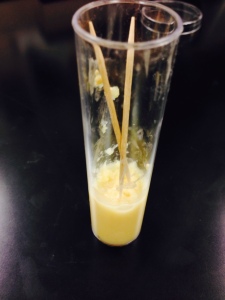Day 35-38: Counting is Hard
Remember when I said Inquiry is hard? Apparently, I was getting ahead of myself. Counting is hard. No, not that counting. Like, the 1, 2, 3 kind of counting.
Some days I need to breath and realize the hardest things for high schoolers can be the most mundane and seemingly simple tasks.
So Wednesday and Thursday we took a look at our flies and removed any larva that had hatched and placed them in a culture tube. This requires students to examine their petri dishes closely, to see if hatched larva are crawling around. They then picked them up with a toothpick (all if them at once if they could) and placed the toothpick in the tube. This makes it easy for the larva to crawl off instead of trying to make them get off.
Teacher prep note: You’ll want to “score” the top layer of your fly food. This requires a normal amount (8-10 grains) of yeast and then 3 drops of water and using a popsicle stick, knife, of something flat you want to mash the top layer (see pic above) so that it becomes mashed and the yeast is mixed in. This is easier for the larva to eat, rather than regular sized yeast for adult flies.
After transferring the larva we marked on the tube how many were in there, for our data purposes. We did this for two days, which allowed for the embryos to have plenty of time to hatch if they were going to (aka – not die).
Today we took the petri dishes and counted* the remaining intact embryos, meaning the dead ones (They had been incubated for almost 4 days). This task was also not easy because of the technique of picking up embryos with toothpicks. A quick how-to video can be viewed here, skillfully captured with one hand holding the camera over the scope lens and the other picking embryos. We placed those embryos on a microscope slide because since they are dead we want to examine them closer up to see WHY they died. The directions students got can be seen below:
Students were asked to place ANY embryo that still had an organism in it (see: dead) to be transferred to a microscope slide. They then had to record how many that was. Remember, previously they had recorded how many larva they had and of course the initial number of embryos they started with. The bleach was just ordinary bleach and was used to dissolve the egg shell. Our wicking device was cut up pieces of notecard. The water can be immediately wicked away after application, it’s just used to wash away the bleach. I then dropped in one drop of Hoyer’s Medium which is used as a mounting solution. Then to facilitate the mounting we placed them under a heat lamp that had been heating a hardtop surface to 37°C, although warmer is better, I wouldn’t go lower. That heat was applied for a couple hours.
Due to MLK day Monday we will be waiting a couple days for our larva to develop into flies and we’ll be back in business on Friday. Until then, happy trails.
*Why is this part so hard for students to do correctly? Explaining the importance of having accurate data and not quitting, even if they have a lot of embryos, seems to not make a difference to most. #FreshmanProblems?



